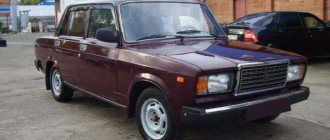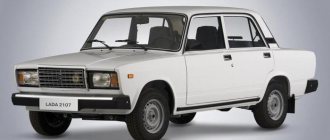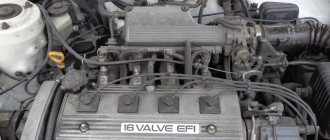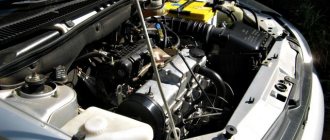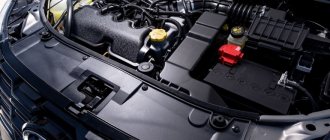Technical characteristics of the Oka car
Name Car VAZ-1111 VAZ-1113 Number of seats 4 Number of seats with the rear seat folded 2 Useful weight, kg: 340 Weight of transported cargo, kg with driver and three passengers with driver and passenger 40 190 Weight of curb vehicle (fully fueled and loaded, but without payload), kg 635 645 Vehicle clearance with total weight with a static tire radius of 237 mm, no less, mm to subframe to engine oil pan 150 170 Outer smallest turning radius along the axis of the front wheel track, no more, m. 4.6 Maximum speed, km/h with full weight with driver and one passenger 115 120 130 135 Acceleration time from standstill with gear shifting to a speed of 100 km/h, with full weight with driver and one passenger 36 30 24 20 Maximum grade overcome by the vehicle with full weight, on a section of dry, level and hard ground without acceleration in first gear (for a run-in car with a running-in engine, the length of the climb is at least twice the length of the car), % 30 Braking distance of a car with the highest load from a speed of 80 km/h on a horizontal section of a dry, flat asphalt highway, no more than, m when using the service brake system when using one of the circuits of the work system 43.2 93.3 Engine Model VAZ-1111 VAZ-1113 Type four-stroke, gasoline, carburetor Number and arrangement of cylinders 2, in line Cylinder diameter and piston stroke, mm 76x71 82x71 Displacement, l 0.649 0.749 Compression ratio 9.9 Rated power at a crankshaft speed of 5600 rpm according to GOST 14846Ch81 (net), kW (hp) 21.5 (29.3) 24.3 (33) Maximum torque at a crankshaft speed of 3200 rpm according to GOST 14846Ch81 (net), N.m (kgf.m) 44 (4.5) 50 (5.1) Transmission Single-disk clutch, dry, with a central pressure spring Clutch release drive - cable, backlash-free Gearbox four-speed, with synchronizers in all forward gears. Main gear cylindrical, helical Differential bevel, two-satellite Front wheel drive shafts with constant velocity joints Chassis Front suspension independent, with telescopic hydraulic shock absorbers, with coil springs, lower wishbones with braces and anti-roll bar Rear suspension on longitudinal, interconnected levers, with helical coil springs and telescopic, double-acting hydraulic shock absorbers Disc wheels, stamped rim size 4B-12H2 for tubed and tubeless tires Radial, low-profile, tubed or tubeless tires. Size - 135/80 R12 Steering Injury-proof type Steering mechanism rack and pinion Steering drive two rods with hinged fastening to the ends of the rack and a swivel connection with rotary levers Brakes Service brake system: front disc brake mechanism, with a movable caliper and automatic adjustment of the gap between the disc and pads Rear drum brake mechanism, with self-aligning pads, with automatic or manual adjustment of the gap between the pads and the drum Hydraulic brake drive, dual-circuit with diagonal separation of circuits, with a vacuum booster and pressure regulator Manual parking brake, with cable drive on the brake pads of the rear wheels The electrical circuit is single-wire, the negative pole of the power supplies is connected to ground. Rated voltage 12V. Rechargeable battery 6ST-36A, charge 130,000 C (36 Ah) Generator 37.3701, alternating current, with built-in rectifier on silicon diodes and electronic voltage regulator. Return current 55 A at 5000 rpm' Starter 39.3708, remote control, with electromagnetic activation and freewheel Body Model VAZ-1111a Type all-metal, load-bearing, three-door
Gear ratios of the 5-speed gearbox:
first gear... 3.7 second gear... 2.06 third gear... 1.27 fourth gear... 0.90 reverse... 3.67 final drive... 4.54 (4.1)
Basic data for adjustments and control:
Parameter Value Tolerance Clearances in the valve drive mechanism on a cold engine, mm: for intake valves for exhaust valves
+0.05. -0.05 + 0.05. -0.05 Minimum crankshaft rotation speed, min 820.900 Oil pressure in the engine lubrication system at an oil temperature of 85C and a crankshaft rotation speed of 5600 rpm, not less, MPa (kgf/cm*2) 0.45 (4.5) Minimum oil pressure in the engine lubrication system at an oil temperature of 85C and a crankshaft speed of 820.900 min", MPa (kgf/cm*2) 0.08 (0.8) Liquid temperature in the cooling system of a warm engine at an air temperature of 20.30C, full load and driving at a speed of 80 km/h, no more, C 95 Coolant level in the expansion tank on a cold engine, above the MIN mark, mm 25.30 Density of Tosol-A40 coolant at 20C, g/cm^3 1.078 - 1.085 Gap between electrodes spark plugs, mm 0.7 - 0.8 Initial ignition timing to TDC, degrees VAZ 1111 VAZ 11113
Small KAMAZ
Although the development of the small car was carried out in Serpukhov, it was supposed to be launched into mass production in Elabuga, and since the city is located on the Kama River, the model was given the name “Kama” VAZ 1111. But due to the unstable economy then in the Soviet Union, there were no plans not destined to come true - the production of the brand in the planned volume (900 thousand cars per year) did not work out, and the Elabuga plant was repurposed. VAZ-1111 began to be produced in smaller volumes, and at other enterprises:
- at the Volzhsky Automobile Plant in Tolyatti;
- in Serpukhov (SeAZ);
- in Naberezhnye Chelny (ZMA).
In Togliatti, the production of a small car did not last long - its production on the main AvtoVAZ conveyor was unprofitable, and in 1995 the Oka was removed from the assembly line. The small car plant (ZMA) in Naberezhnye Chelny produced Oka until 2005, and the letters “KAMAZ” were proudly displayed on the nameplates of small cars.
Production Edit
Initially, the car was produced at the Volzhsky Automobile Plant, therefore it is designated VAZ-1111 (hereinafter VAZ-11113). Later, production of the Oka was also transferred to Serpukhov to SeAZ (where the development of this vehicle initially began) and to Naberezhnye Chelny to ZMA (the passenger division of KamAZ). At VAZ, production of the Oka was stopped in 1995 due to the low profitability of producing a cheap minicar at VAZ's main facilities. Around the same time, a 0.75-liter 2-cylinder 35-horsepower engine was developed to replace the 0.65-liter 31-horsepower engine. New 35-horsepower VAZ-11113
it was also a “half” of the more powerful and high-torque 1.5-liter VAZ-21083 engine.
At the end of 1998, after the default and sharp devaluation of the ruble, the Oka microcar turned out to be one of the cheapest vehicles in the world (!), which sharply boosted its popularity in the domestic and foreign markets. Until 2005, ZMA and SeAZ constantly increased production of the only domestic model in segment A, but later the demand for the obsolete Oka began to fall due to the revaluation of the ruble and the influx of more modern foreign cars (primarily Chinese). In addition, AVTOVAZ curtailed engine production for the Oka, considering it unprofitable to further adapt it to Euro-2 standards introduced in the country in 2006, which required replacing a cheap carburetor with an expensive injection system and using a catalytic converter in the exhaust system.
"Oka" SeAZ
In 2006, the small car division in Naberezhnye Chelny was sold, and therefore the production of the “little Kamaz” was overthrown, and the Oka was now produced only at the Serpukhov plant. But the demand for an obsolete car was no longer the same, and in order to somehow arouse interest among buyers, SeAZ decided to modernize the brand.
In 2006, Oka began to be equipped with a Chinese-made 1.0 liter engine, the modification was named SeAZ-11116. But the demand for the car was falling, and besides, it was unprofitable to produce a small car, and in 2008, mass production of the model was discontinued.
Reviews
I read reviews on the Internet about OKA cars of various modifications. Let me tell you in a nutshell. Many people do not like this car because of its appearance, but many are pleased that it is a simple, easy to repair, two-cylinder internal combustion engine with two valves. Another disadvantage is that it is lightweight, and when driving along the highway behind an oncoming truck or van, the Oka is practically blown away by the wind. In addition, one of the disadvantages is that the distance between the wheels is less than that of standard cars, so in winter it does not get into ruts and throws them out. Some call it the "crazy stool."
As for me, you can take it if you do not travel long distances, for example, a postman delivers a newspaper. Fuel consumption is low.
Modifications
Over the years of production of the Oka model, many of its modifications were released. The car was produced with two main types of engines - 0.65 and 0.75 l, and depending on the installed power unit, it could have an index of 1111 (0.65 l) or 11113 (0.75 l). The factory designation of the model indicated the Volzhsky or Serpukhov Automobile Plant - VAZ or SeAZ, the cars were produced in various versions:
- for disabled people – SeAZ-1111-01/ SeAZ-1111-02/ SeAZ-1111-03 with a 0.65 l engine and SeAZ-11113-01/ SeAZ-11113-02/ SeAZ-11113-03 with a 0.75 l engine ;
- basic models - VAZ-1111 and VAZ-11113;
- a car with a 4-cylinder engine from Tavria - Astro-11301;
- model with a 1.0 liter engine in various modifications of SeAZ-11116, including pickups and vans.
Production history
Later, Oka production was also transferred to Serpukhov to SeAZ and to Naberezhnye Chelny to ZMA (the passenger division of KamAZ). At VAZ, production of the Oka was stopped in 1995 due to the low profitability of producing a cheap minicar at VAZ's main facilities. Around the same time, a 0.75-liter 2-cylinder 33-horsepower engine was developed to replace the 0.65-liter 29.7-horsepower engine. The new 33-horsepower VAZ-11113 engine was also a “half” of the more powerful and high-torque 1.5-liter VAZ-21083 engine.
At the end of 1998, after the default and sharp devaluation of the ruble, the Oka microcar turned out to be one of the cheapest in the world [ source?
] means of transportation, which sharply boosted its popularity in the domestic and foreign markets. Until 2005, ZMA and SeAZ constantly increased production of the only Russian model in segment A, but later the demand for the obsolete Oka began to fall due to the revaluation of the ruble and the import of more modern cars (primarily Chinese). In addition, VAZ curtailed engine production for the Oka, considering it unprofitable to further adapt it to Euro-2 standards introduced in Russia since 2006, which required replacing a cheap carburetor with an expensive injection system and using a catalytic converter in the exhaust system.
In 2006, production of Oka at ZMA was discontinued due to the purchase of this enterprise (now Sollers). At the remaining only SeAZ, in 2006, production of its modification SeAZ-11116 with an imported Chinese 3-cylinder 1.0-liter injection engine (licensed engine from Daihatsu Charade G10) was launched, and in 2007 an attempt was made to produce (only a pilot industrial batch) of pickups and vans of the SeAZ-11116-50 subfamily, and a reinforced version of the SeAZ-11116-60 pickup, semi-frame design, with a load capacity of 400 kg, was developed. Soon after this, SeAZ stopped producing cars with Russian engines, completely switching to a Chinese unit.
Over the years of production, the Oka was regularly modernized: the instrument panel, the heating and ventilation system of the body, as well as some body parts, primarily the plastic body kit, including the radiator grille and bumpers, were repeatedly changed. Larger wheels began to be used (13″ instead of 12″). The Chinese 3-cylinder engine installed on the SeAZ-11116 develops one and a half times more power (53 hp versus 35 hp) with significantly less noise and vibration, which, together with a 5-speed gearbox, improved acceleration dynamics and increased the maximum speed , and also ensured compliance with environmental standards Euro-2, and since January 2008 - Euro-3.
In November 2008, SeAZ stopped production of Oka due to its unprofitability. By the end of the year, the remaining commercial vehicles were sold, and since March 2009, SeAZ has been in a state of conservation and sold off excess equipment, but at the same time maintains a number of vital workshops, for example, galvanizing, in working order. (Autoreview No. 20 for 2010 | “How SeAZ dies”). Still, in 2010, several OKA pickup trucks were produced.
VAZ 11113 Oka: technical specifications
The VAZ 11113 car is produced only in a hatchback body, in a three-door version, the car is designed for 4 people, including the driver. "Oka" has front-wheel drive, independent front and rear suspension, is equipped with a two-cylinder engine and 4-speed. manual transmission. The front suspension is standard for a car of this class, MacPherson type; a rigid beam with springs and shock absorbers is installed on the rear axle.
The brake system is hydraulic, with discs installed on the front axle and drums on the rear axle. Mechanical steering, hydraulic or electric power steering are not provided. The brakes have a vacuum booster and a master cylinder, a cable-type clutch without hydraulic release.
The engine of the VAZ-11113 model is two-cylinder, its location under the hood is transverse, some parts of the power unit are unified with the VAZ 21083 internal combustion engine (pistons, piston rings/pins). The cylinder block of the small engine is cast iron, the cylinder head is cast from aluminum. The timing drive is a belt drive, the camshaft is located at the top, in the bed of the cylinder head.
The VAZ 11113 “Oka” car has the following technical characteristics:
- dimensions (length/height/width) – 3.2 / 1.4 /1.42 m;
- wheelbase – 2.18 m;
- ground clearance – 15 cm;
- curb weight - 0.645 tons;
- maximum laden weight – 0.98 tons;
- wheel track (front/rear) – 1.21/1.2 m;
- ICE power – 35 hp. With.;
- ICE volume – 749 cm³;
- fuel system type - carburetor;
- fuel used - AI-92 gasoline;
- diameter of standard rims – R12
Engine cutaway view
The VAZ car surprises with its technical characteristics despite its more than modest size. The Oka accelerates quite quickly, has excellent cross-country ability, and at the same time is very economical in fuel consumption. But the new product did not go into wide production due to many problems and the need for improvements, although today you can still buy a kit to convert the engine into an injection one.
Repair of VAZ 11113 Oka
The Oka car has high maintainability; servicing the car is very simple. But the disadvantage of the VAZ model is that it constantly requires repairs - something is bound to break. The reason for regular breakdowns is the short service life of many parts and the low quality of spare parts.
The most common chassis parts that fail are:
- ball joints;
- steering tips;
- hub bearings.
It is not so rare for CV joint boots to tear, both external and internal. If you don’t take care of the boot in time, the “grenade” begins to “crunch”, and the hinge also has to be changed. Brake hoses don't last long and the rubber on them cracks.
Electrical problems at Oka constantly arise:
- short the wires;
- the ignition coil fails;
- breaks through high-voltage wires;
- The electric cooling fan stops working.
Of course, all of the above applies to used cars with a solid mileage, but the car has not been produced for a long time, and it is difficult to buy a car in perfect condition.
The VAZ-11113 must be driven through puddles very carefully - if the ignition module gets wet, the car cannot be started. Many drivers try to isolate the reel from moisture, for example, by wearing a rubber glove. For such a “crumb”, the service life of its engine is not bad; during normal operation, the engine can be maintained for 120-150 thousand km without problems. It is important to monitor the performance of the electric cooling fan - if it fails, the internal combustion engine overheats, and then its service life is noticeably reduced.
Unlike the standard VAZ 4-cylinder engine, the Oka engine is equipped with balancer shafts for more stable operation. If for some reason the balancing goes wrong, the internal combustion engine begins to operate with terrible vibration.
The gearbox (4-speed manual) is quite reliable, and there are no chronic diseases. The only drawback is increased howling, but this defect is typical for many front-wheel drive VAZ cars and does not affect driving performance in any way.
Repairing a VAZ 11113 Oka is generally inexpensive, and spare parts for the car are cheap. It is relatively expensive for a car owner to repair a gearbox at a car service center - it is difficult to remove and install the gearbox.

